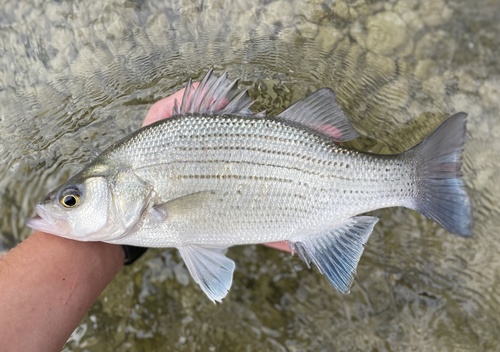
White Bass
The Atlantic Bluefin Tuna (Thunnus thynnus) is a highly migratory, large pelagic fish renowned for its size, speed, and commercial value. It plays a critical role in the marine ecosystem and is a top predator. Sadly, is it endangered.
4 9 years
Lifespan
25 - 45 cm
Length
Least Concern
Conservation Status
19 km/h
Swimming speed
Carnivorous
Diet
Local Migration
Migration
Appearance Overview
The Atlantic Bluefin Tuna showcases a robust, streamlined body, perfectly adapted for speed and endurance in the water.
Coloration
Dark metallic blue on the dorsal side, transitioning to a silvery-white on the ventral side
Body Shape
Torpedo-like shape optimized for efficient swimming
Fins
Two dorsal fins, the first being depressible; a series of finlets running from the dorsal and anal fins to the tail
Scales
Small and cycloid, contributing to its smooth, hydrodynamic surface
Length
Commonly up to 6.6 ft (2 meters), can reach up to 13 ft (4 meters)
Weight
Typically around 550 lbs (250 kg), maximum recorded weight is about 1,500 lbs (680 kg)
Diet
Carnivorous, feeding on a variety of fish (such as mackerel, herring, and hake), squid, and crustaceans.
Feeding Behavior
An opportunistic predator, the Atlantic Bluefin Tuna uses its speed and agility to hunt. They often push prey to the surface and may feed in coordinated groups, especially when targeting schooling fish.
Social Behavior
Highly migratory, known to form large schools, particularly during spawning and feeding. Schools can sometimes be segregated by size, and they may mix with other tuna species.
Commercial Relevance
Extremely high value, especially in the sushi and sashimi markets of Japan. Its rich, fatty flesh is considered a delicacy, leading to high prices at auction.
Conservation measures
Subject to international fishing quotas managed by organizations like the ICCAT (International Commission for the Conservation of Atlantic Tunas). Measures include minimum size limits, fishing seasons, and catch limits. Marine Protected Areas and efforts to reduce bycatch are also in place.
Status
Endangered (IUCN Red List)
Threats
Primarily threatened by overfishing, driven by the high demand for its meat. Climate change and habitat degradation also pose significant risks, impacting their spawning grounds and prey availability.
Habitat Distribution
Depth Range
Typically found from the surface to depths of 1,600 ft (500 meters), but can dive deeper, up to 3,300 ft (1,000 meters) or more.
Geographic Range
Found throughout the North Atlantic Ocean, including the Mediterranean Sea. The western Atlantic population ranges from Newfoundland to the Gulf of Mexico, while the eastern Atlantic population ranges from Norway to the Canary Islands.
Preferred Environment
Prefers temperate waters, but its unique physiology allows it to tolerate a wide range of temperatures. It is a highly migratory species, often found in both coastal and open ocean environments.
Reproduction and Life Cycle
Breeding Habits
Spawns in two main areas: the Mediterranean Sea and the Gulf of Mexico. Spawning occurs in warm waters, with specific timing varying by location (May-June in the Gulf of Mexico, June-July in the Mediterranean).
Development Stages
Eggs are pelagic and hatch into larvae within a few days. The larvae are planktonic and undergo rapid growth, developing into juveniles that resemble miniature adults. Growth continues to be rapid in the early years of life.
Fecundity
Highly fecund; a single female can produce up to 30 million eggs per spawning season. The number of eggs increases with the size and age of the female.
Maturity Age
Reaches sexual maturity at different ages depending on the population. Western Atlantic Bluefin Tuna typically mature at 4-5 years, while Eastern Atlantic Bluefin Tuna mature at around 5-8 years.
Faqs about White Bass
Where are Atlantic Bluefin Tuna found?
They are primarily found in the Atlantic Ocean, ranging from the cold waters of the North Atlantic to the warmer tropical waters of the Gulf of Mexico and the Mediterranean Sea.
How fast can Atlantic Bluefin Tuna swim?
Atlantic Bluefin Tuna are among the fastest fish in the ocean, capable of reaching speeds up to 43 mph (70 km/h) in short bursts.
Is it legal to fish for Atlantic Bluefin Tuna?
Yes, due to their endangered status and the strict regulations in place to manage their populations. It's crucial to ensure that any Bluefin Tuna consumed is sourced sustainably and legally.
What is unique about the Atlantic Bluefin Tuna's physiology?
They have a unique ability to maintain a body temperature higher than the surrounding water, which helps them survive in a wide range of temperatures and enhances their muscle efficiency.
How long do Atlantic Bluefin Tuna live?
They can live for up to 40 years, although their lifespan can be affected by fishing pressure and environmental conditions.
What do Atlantic Bluefin Tuna eat?
Their diet mainly consists of smaller fish, squid, and crustaceans. They are opportunistic predators that feed on whatever prey is available.
When and where do Atlantic Bluefin Tuna spawn?
Spawning typically occurs in warm waters, with major spawning grounds in the Mediterranean Sea and the Gulf of Mexico. The timing can vary, but it generally happens in spring and summer.
How many eggs do Atlantic Bluefin Tuna lay?
Females can release millions of eggs per spawning season. The exact number can vary depending on the size and health of the fish.
At what age do Atlantic Bluefin Tuna reach maturity?
They reach sexual maturity at around 4-8 years of age, although this can vary between different populations and locations.
Copyright @ Nature Style Limited. All Rights Reserved.
 English
English